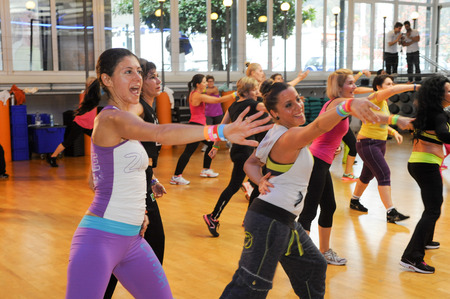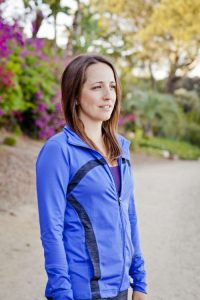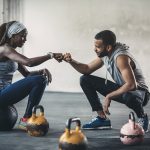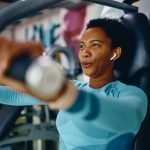
Preparing for a personal trainer interview looks similar to interviewing for other types of professional jobs. You will be put under what feels like a microscope, asked to showcase your best attributes and acknowledge your weaknesses. It is also common practice to require those interviewing for a personal training or group fitness position to demonstrate their skills by performing a sample workout or lead a small group class. The interview team or hiring manager will likely provide you with guidelines if they ask interviewees to perform a “training demo” or “workout session”.
Let’s discuss what to expect during a personal training position interview from start to finish.
Preparing for the Personal Trainer Position Interview
Your job in the interview is to teach the job interviewer or committee about who you are and why you make a quality candidate for the position. Ease your nerves by researching the people and place where you want to work. Locate their mission statement and the type of client they serve.
Prepare and review your curriculum vitae or resume before the interview. It’ll boost your confidence to identify customer service skills from a job unrelated to the fitness field or a contact you have that might help the organization you are applying to.
Personal Trainer Interview Attire
Depending on the facility, you may be asked to have both face-t0-face and practical interview at the same time, but usually they will be on separate days. A good rule of thumb for a face-to-face discussion is business casual (slacks, nice top, dress shoes). Avoid tank tops or revealing clothing, and opt for close-toed shoes. Pack a coordinated set of workout clothes and appropriate footwear in case you are asked to teach a class or demonstrate exercises. You could also visit the site ahead of time and take a quick inventory of what the “attire theme” appears to be with the current employees.
Also, refrain from wearing too many accessories as this can be distracting to the committee and create wardrobe issues if you need to change quickly to prepare for the next phase of the interview.
Do ease up on the cologne or perfume, but don’t forget deodorant. In fact, throw a stick in your gym bag to have with you for the workout demo. The last thing you want is to give the committee the impression that you are a Stinky Steve or Sweat Betty. Keep it fresh.
Attire for the Practical Demonstration
Use your best judgment here. You don’t know who your audience will include (most likely) and you probably do not have a good feel for the personalities in the room. Choose conservative workout attire that is nicely coordinated and matching. Your role in the practical portion is to show them what you know and how well you know it. Your job is NOT to show off or grandstand your “assets”.
For men, a short-sleeved workout shirt, and athletic pants or shorts. Avoid baggy sweats, stained shirts, and/or anything that looks like you’ve either slept in your clothes or mowed the lawn. Wear supportive athletic shoes (no flip flops or boat shoes).
For women, choose appropriate-length shorts (not booty shorts) or leggings/athletic/Yoga pants. For tops, make sure what you select covers the torso and isn’t cut too low or has spaghetti straps. For shoes, the same rule applies; wear supportive athletic shoes (no flip-flops or casual footwear).
Dress to impress and do so appropriately for all parts of the interview. If you’re unsure which direction to go, making a quick phone call to the hiring manager or interview committee chair can clarify expectations. It’s ok to ask!
What to Expect in a Personal Trainer Interview
This element can vary. You can likely, however, expect the following:
- A team of interviewers (two to three)
- A site or facility tour
- A presentation (teaching or training demo, mock client session, class, etc.)
- A 45-minute (give or take) question/answer session with the interview team or manager
- An opportunity to ask questions of the interview team or hiring manage
Personal Trainer Interview Questions
This is the heart of an interview. There might be five questions, there might be twenty. If you get nervous answering questions, practice ahead of time with a friend, colleague, or family member.
Generally, the questions you will be asked during an interview for a personal trainer position are not too dissimilar from those you would be asked for other jobs.
First, always be prepared to answer this question: “Why this organization and why this position?” More often than not a committee or interviewer will want to gauge your interest and learn something more about you without asking direct questions.
This question (or versions like it) offers you an opportunity to hit a home run and speak to what attracts you to the organization. This would be an opportune time to discuss what aspects of the mission, vision, values, etc. resonate with you the most and what excites you about the possibility of joining their team.
Be prepared to offer a solid and detailed answer without saying “I like fitness” or “I saw it posted and thought it looked interesting.” Trust me, the interview will be over before it even begins if you give a vague and lackadaisical response. The following are questions I’ve been asked as a candidate or asked of those I interviewed.
Common Personal Trainer Interview Questions
- Tell us a little about yourself.
- Describe your experience in the industry?
- Tell us about your training philosophy?
- How do you keep clients motivated and engaged?
- How do handle conflict or work with challenging clients?
- What do you see as your greatest strength? Weakness?
- What are your professional goals you wish to achieve in 5-10 years?
- What hours do you prefer to work?
- How would your colleagues describe you?
- Do you feel drawn to a certain demographic (i.e. Athletes, Young Adults, Special Populations)? Explain.
- What would you hope to gain by working here? What can you do for us?
- What makes you the ideal candidate for this position?
Personal Training Mock Interview – watch a fitness professional answer these questions live!
In addition to preparing strong answers to common questions, remember to bring extra copies of your resumé and/or a portfolio. Client testimonials are often compelling “extras” and offer something unique to you and will provide employers with a tangible product that displays your work.
What Questions to Ask During the Interview
You made it through the questioning period; now it’s time to “cross-examine” the committee. This is often my favorite part of an interview because it gives you a chance to learn a little more about the personalities in the room, the culture of the organization, and the expectations the employer has.
During the interview, when you have a chance to ask questions of the panel, ask what their goals and objectives are or if they have a five and ten-year plan. Now is when you can offer some innovative ideas that you spent time nurturing before the interview.
Finally, create a list of intelligent questions prior to the interview. Here are some ideas of questions to ask that can easily be modified or adapted to fit the setting or company.
- What do you feel are the most important qualities or characteristics required for a candidate to excel in this position?
- Is this a new position? If not, can you tell me why the previous employee vacated the role?
- Can you tell me a little about the culture of this organization and the values of its leadership?
- What are the biggest challenges you face as a team?
- What do you see as the greatest opportunity for this organization?
- Who would you consider to be your biggest competitors and what makes your organization better?
- What do you expect to see in the first six months of hiring someone for this position? In a year?
- What do you like best about working here?
- What is your expected timeline for hiring? And/or what are the next steps in the interview process?
- How do you help your team grow professionally?
Keep the questions you ask to a manageable number (5-7 is a nice average). The only thing worse than not asking any questions of the committee is asking too many and then making them feel as if it’s an inquisition rather than information gathering and dialogue.
Personal Trainer Practical Interview Portion
This is where the situation can become a little more “best guess” than “absolute” because every gym conducts interviews differently and follows a different protocol for client intakes, assessments, and programming. However, it is not uncommon to be presented with any one of the following scenarios.
- A mock client profile you are expected to evaluate and stratify his/her risk
- Leading a client session using a workout provided to you by the committee
- Leading a small group fitness class or workout with three to five participants
- Observing a mock client-trainer session in which you are asked to identify errors
Ideally and hopefully the hiring manager or interview committee will provide you with details as to what they expect. However, if they do not, ask for some additional information. At a minimum, you will need to know any special conditions and/or the overall health risk profile of those who will be participating in the class or session demo.
Preparing for the Practical Basics
If you are asked to perform a workout or teach exercises, the facility should provide you with guidelines. If the details seem “fuzzy”, ask for clarification.
Other questions to ask:
- Are there special conditions the client or group members may have?
- What is the health risk profile?
Remember – the first step is knowing the client goals and moving forward from there. Also, be prepared to justify why you chose the exercises you did as well as how those exercises could be modified to either decrease or increase the challenge.
As we all know, there’s not one right program for every person. That said, there are some basic skills and abilities you will need to be able to demonstrate and execute regardless of the scenario you are given. Ask yourself how confident you feel in being able to:
 Prepare an example of a new client intake folder complete with common forms (PAR-Q, Health Status Questionnaire, Lifestyle/Behavior Questionnaire, Goal Sheet, Medical Release (if necessary), and basic physical assessment forms, etc.). If nothing else, this provides the committee with a model of your process for handling a new client intake
Prepare an example of a new client intake folder complete with common forms (PAR-Q, Health Status Questionnaire, Lifestyle/Behavior Questionnaire, Goal Sheet, Medical Release (if necessary), and basic physical assessment forms, etc.). If nothing else, this provides the committee with a model of your process for handling a new client intake- Demonstrate, at a minimum, resting heart rate, body composition (probably using skinfold calipers), postural evaluations, blood pressure (prepare for a manual cuff), & girth measurements.
- Identify potential risk factors and explain how you would handle a client who presents with those risk factors
- Hold a short conversation about the client’s goals (or group participants’ goals for the workout)
- Demonstrate modifications for basic exercises that either decrease or increase the challenge
- Construct a full-body workout and explain the exercises you chose and how they relate to a client’s goals
- Correct form
Whatever areas you feel are “weakest”, concentrate on building those skills before the interview.
Frequently Asked Questions About Personal Trainer Interviews
What’s the best way to prepare for the interview?
- Start by doing some homework. Research the company or organization to get a sense of its culture and values. Pay a visit to the physical location to feel the space and take a look around.
- Ask yourself, “Why do I want this job?” and, “What makes me the best person?” You need to sell yourself on the job before you can convince the committee of their need to hire you for the job.
What should I bring with me?
- A set of professional workout clothes for the practical portion of the interview.
- A sample of a client intake folder/client records.
- Extra copies of your CV or resume.
- A confident attitude.
Other Preparation Tactics
While it isn’t possible to predict all the expectations of the committee leading your personal training interview, you can give yourself the added edge by being ultra-prepared. Approach the interview the way you would approach working with a new client – be confident, warm, and encouraging.
I also recommend visiting the facility in advance to examine what the space is like and what equipment is available. Spend some time crafting different workouts in your mind (or on paper) to “study” for this practical portion of the interview. If you enter the interview with three or four workout designs (maybe one is a full-body, another is a core, and another is H.I.I.T. workout, etc.), you will have a variety of exercises to demonstrate with whomever your audience turns out to be.
Don’t forget to include the warm-up and cool-down. Show that you have the skills to craft a well-rounded and balanced workout regimen for any client while still being mindful of what his or her goals are.
More chatter about practical personal training interviews in this episode of NFPT Live:
How long should I wait to follow-up?
- After you have your interview, send a thank you email to each individual committee member that does two things: thank them for their time and for allowing you the opportunity to interview with them and reiterate your excitement about the position.
- If more than a week goes by and the committee has not followed-up with you, it’s okay to call and inquire about an update.
Interviewing is a stressful and time-consuming process, but taking some active and intelligent steps to adequately prepare will help alleviate some of that stress and anxiety. If you are nervous, it means the opportunity in front of you excites you, which means it matters. Use that nervous energy to fuel and motivate you to impress the panel and, hopefully, land the job!






